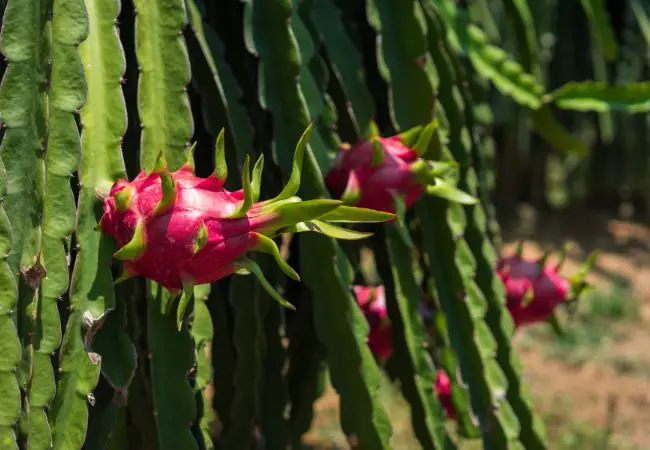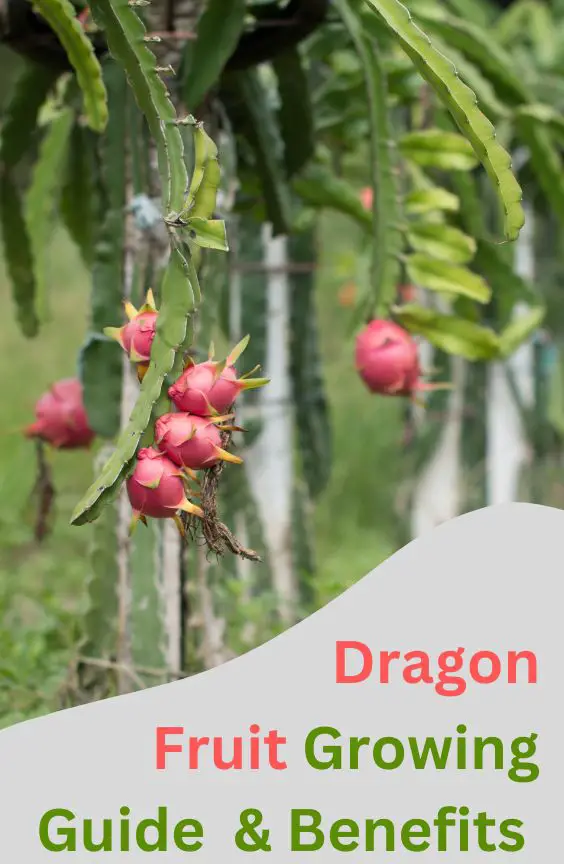Dragon Fruit Care and Benefits

Dragon fruit care and benefits that you will get after eating this fruit. Dragon fruit, also known as pitaya, is a tropical fruit that has gained immense popularity in recent years.
Dragon Fruit Care and Benefits
Dragon fruit has a unique appearance, vibrant colors, and delicious taste that make it a favorite among fruit enthusiasts and health-conscious individuals.
I was stoked to harvest my first dragon fruit and if you’re considering growing dragon fruit, this comprehensive guide will provide you with all the necessary information to successfully cultivate and care for this exotic plant.
Dragon Fruit Growing
You need to be patient when growing dragon fruits. If you grow them from a healthy cutting, you can get fruit between 8-12 months. However, if you grow them from seed, they can easily take more than 2 years to produce any flowers.
Once established, dragon fruits will produce fruits for about 5 months of the year. They will also continue producing fruits for many years to come.
Dragon fruit comes in different varieties, each with its own characteristics and growing requirements. It’s crucial to choose the right variety that suits your climate and preferences.
I Choose a variety that is commonly grown for its sweet and flavorful fruit. Some people also decide between the white and red types.
When selecting a planting location, ensure it receives full sun exposure and has well-draining soil. Prior to planting, prepare the soil by incorporating organic matter and ensuring a pH level between 6 and 7.
Planting Dragon Fruit
Propagation of dragon fruit can be done through seeds or cuttings, but cuttings are the preferred method due to their ability to produce fruit faster.
Take cuttings from mature and healthy plants, allowing them to dry for a few days before planting. To plant, dig a hole and place the cutting at a 45-degree angle, leaving the top exposed.
Space the plants adequately, considering their climbing nature, and provide a trellis or support structure for the plants to climb on.
Watering and Irrigation
Dragon fruit requires regular watering, especially during the growing season. However, overwatering can lead to root rot, so it’s essential to maintain a balance.
Water deeply once a week, allowing the soil to dry out slightly between waterings. During periods of drought or extreme heat, increase the frequency of watering.
Proper drainage is crucial, so ensure the planting area has well-drained soil or use raised beds to prevent waterlogging.
Fertilization
Dragon fruit is a nutrient-hungry plant, and regular fertilization is necessary for optimal growth and fruit production. Conduct a soil test to determine nutrient deficiencies and adjust accordingly.
Use a balanced fertilizer with a higher phosphorus content to promote flowering and fruiting. Apply the fertilizer every four to six weeks during the growing season, following the manufacturer’s instructions.
Additionally, supplement the plants with organic matter such as compost or well-rotted manure to improve soil fertility.
Pruning and Training
Pruning plays a vital role in shaping the dragon fruit plant, managing its growth, and maximizing yield. Start pruning when the plant reaches around one meter in height.
Remove any damaged or diseased branches and promote airflow by thinning out crowded areas. Pinch off the terminal bud of the main stem to encourage lateral branching and bushier growth.
As the plant grows, train the branches onto the trellis or support structure, ensuring they have proper support and are evenly spaced.
Pest and Disease Management
Dragon fruit plants are relatively pest and disease-resistant, but occasional issues may arise. Common pests include mealybugs, aphids, and fruit flies.
Regularly inspect the plants for any signs of infestation and employ natural control methods like introducing beneficial insects or using organic pest control solutions.
Disease prevention involves maintaining proper airflow, avoiding waterlogging, and removing any infected plant material promptly. Fungal diseases like anthracnose can be prevented by applying a copper-based fungicide.
Harvesting and Storage
Knowing when to harvest dragon fruit is crucial for the best flavor and texture. The fruit should be fully colored, firm, and slightly soft to the touch.
Harvest by cutting the fruit from the stem using a sharp knife or pruners. Handle the fruit carefully to avoid bruising.
After harvesting, dragon fruit can be stored for a few days at room temperature. However, for longer storage, it is best to refrigerate them.
Place the fruits in a perforated plastic bag and store them in the refrigerator’s crisper drawer. Dragon fruit can stay fresh for up to one week when stored properly.
Benefits Of Dragon Fruit
Dragon fruit not only boasts a visually striking appearance but also offers numerous health benefits. Let’s explore some of the key benefits of consuming dragon fruit:
Rich in Nutrients
Dragon fruit is packed with essential vitamins and minerals. It is a good source of vitamin C, which supports immune function and promotes collagen synthesis for healthy skin.
Additionally, dragon fruit contains B vitamins, iron, calcium, and phosphorus, all of which contribute to overall health and vitality.
Antioxidant Powerhouse
Dragon fruit is abundant in antioxidants, including vitamin C, beta-carotene, and various flavonoids.
These antioxidants help protect the body against harmful free radicals, reducing oxidative stress and lowering the risk of chronic diseases like heart disease and certain types of cancer.
Hydration and Digestive Health
Dragon fruit has a high-water content, making it a hydrating fruit choice. It also contains dietary fiber, which aids in digestion, promotes regular bowel movements, and supports a healthy digestive system.
Consuming dragon fruit can help prevent constipation and improve overall gut health.
Low in Calories and Fat
For those watching their calorie intake, dragon fruit is a great option. It is low in calories and contains negligible amounts of fat.
This makes it a suitable choice for weight management or for individuals looking to maintain a balanced diet while enjoying a naturally sweet treat.
Potential Blood Sugar Regulation
Dragon fruit has a low glycemic index, meaning it causes a slow and steady rise in blood sugar levels compared to high-glycemic foods.
This characteristic makes it suitable for individuals with diabetes or those aiming to manage blood sugar levels.
Heart Health Support
The combination of antioxidants, fiber, and heart-healthy fats found in dragon fruit can contribute to cardiovascular health.
It may help lower bad cholesterol levels (LDL) and improve good cholesterol levels (HDL), reducing the risk of heart disease.
Hydrating and Youthful Skin
The high vitamin C content in dragon fruit promotes collagen production, which is essential for maintaining skin elasticity and a youthful appearance.
Regular consumption of dragon fruit can contribute to healthy, glowing skin.
Potential Anti-Inflammatory Effects
Some studies suggest that dragon fruit may possess anti-inflammatory properties, thanks to its antioxidant content.
Chronic inflammation is linked to various health conditions, so incorporating dragon fruit into your diet may help reduce inflammation and support overall well-being.
Supports Immune Function
The vitamin C content in dragon fruit plays a crucial role in supporting immune function.
It helps strengthen the body’s defenses against infections, aids in wound healing, and enhances the absorption of iron from plant-based sources.
Versatility and Culinary Delight
Dragon fruit is not only nutritious but also adds a delightful touch to culinary creations.
Its vibrant colors and unique texture make it a visually appealing addition to fruit salads, smoothies, desserts, and even savory dishes. It offers a refreshing and exotic flavor profile that can elevate any recipe.
Troubleshooting Common Dragon Fruit Growing Issues
Sunburn and Sunscald: Dragon fruit plants are susceptible to sunburn and sunscald, especially during the hot summer months.
To protect the plants, provide shade using shade cloth or strategically place them near taller plants or structures that can offer some shade.
Nutrient Deficiencies or Excesses: Conduct regular soil tests to monitor nutrient levels and address any deficiencies or excesses accordingly.
Yellowing leaves may indicate nitrogen deficiency, while stunted growth can be a sign of phosphorus or potassium deficiency.
Adjust fertilization practices based on the specific nutrient requirements of dragon fruit.
Environmental Factors: Dragon fruit thrives in warm tropical climates, but it can also be grown in colder regions.
During winter, protect the plants from freezing temperatures by covering them with blankets or using frost protection measures. Consider growing dragon fruit in containers that can be brought indoors during the colder months.
Dragon Fruit Growing Tips
Pollination Techniques: Dragon fruit flowers are usually pollinated by nocturnal creatures like bats and moths.
If you notice a lack of pollinators in your area, hand pollination can be done using a small paintbrush to transfer pollen from the stamens to the stigma of the flower.
Protecting from Extreme Weather Conditions: Strong winds and heavy rains can damage dragon fruit plants and fruits.
Install windbreaks or place the plants in sheltered areas to protect them from strong gusts. Use stakes or braces to support the plant during heavy fruiting periods.
Winter Care in Colder Climates: In colder regions, where temperatures drop below freezing, it is advisable to grow dragon fruit in containers that can be moved indoors during winter.
Provide sufficient light and maintain a temperature above freezing to ensure the plants survive until spring.
Final Thoughts on Growing Dragon Fruits
Growing and caring for dragon fruit can be a rewarding experience, whether you’re a seasoned gardener or a beginner.
By providing proper planting conditions, and following essential practices such as watering, fertilizing, pruning, and pest management, you can enjoy a bountiful harvest of delicious dragon fruit.
With a little care and attention, your dragon fruit plants will thrive, bringing beauty and exotic flavors to your garden or patio.
I hope this post on dragon fruit care and benefits inspires you to grow this exotic fruit. If you love gardening, please follow me on Multigardening Pinterest for more awesome posts.






